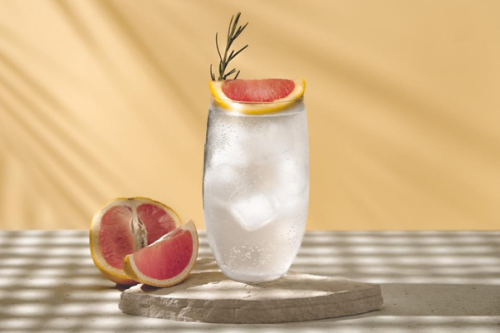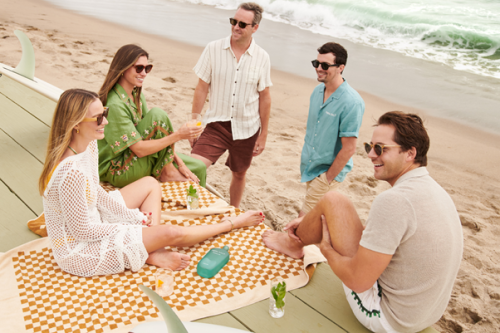Papa Salt Coastal Gin has a unique background in more ways than one


Five friends each picked up a glass from the kitchen table and took a long, slow sip, savoring the flavor of the gin and weighing up whether it was to their taste or not.
One of them, Charlie Maas, was already pouring the next one for them to try. Beside him sat 20 bottles of some of the world’s finest gins, all of them to be rigorously blind-tasted and discussed before the session could end.
It was 2018, and the sun-filled Los Angeles kitchen belonged to Barbie star Margot Robbie and her husband Tom Ackerley.
Maas was there with his wife, Hollywood Producer Regan Riskas. Joining them was best friend Josey McNamara, who, alongside Ackerley, co-founded LuckyChap Entertainment with Robbie.
The reason for the gathering was a random idea they’d had a few months earlier about launching their own brand of gin. They imagined enjoying it with their friends in beach bars on long, hot days and summer evenings.

“The more we talked about it, the more it seemed like a great idea,” Maas remembers. “But we’re five very opinionated individuals, so the first step was seeing if we could reach agreement on exactly what sort of gin we wanted to distill.”
Hence why he had spent the afternoon driving between the local liquor stores to buy a bottle of every variety of gin he could lay his hands on.
“At that stage, all we knew for sure was that we wanted a gin we could drink with our friends all year round, no matter what the weather was doing. So all we had to do was build up the flavor accordingly.”
“I think a lot of people in America wrote off gin a long time ago when all the options were very juniper forward and only mixed with tonic.” – Margot Robbie
Of the five, it was Maas who best understood how that process might work. His family had been in the spirits business for decades and he had spent nine years growing the cream liqueur brand Rum Chata to become a bestseller in the United States and successfully exported it to 26 other countries.
He’d since formed a consultancy to teach other brands how to grow their businesses, something he now had to do for his friends as they bravely embarked on their mass tasting.
“While I was pouring one of the first ones, Tom said, ‘I’ll get the tonic’ and I said, ‘No – you’re drinking it neat!’” Maas laughs. “Part of the reason gin hasn’t caught on is that people think it’s too bitter – and that’s down to the quinine in the tonic.
“Gin isn’t bitter at all. It has that sweet juniper pine note, but you can’t taste that if it’s drowned in tonic. Pretty much my only stipulation was that our recipe had to taste delicious with soda.”

But, no matter how wonderful it might eventually taste, Maas knew there was a major hurdle they’d have to distill down to size if they were going to be successful.
Americans don’t like gin.
While the United Kingdom and Australian markets have exploded over the last 15 years, in the United States, it’s remained stagnant. The average American spends just US$8.43 a year on gin, which is barely one gin and tonic.
Australians splash out more than twice that amount while the thirsty British glug back 15 times as much, with demand projected to grow by a third before 2028. By that date, the global market will have reached US$24 billion.
“I think a lot of people in America wrote off gin a long time ago when all the options were very juniper forward and only mixed with tonic,” Robbie tells The CEO Magazine. “But they’ll eventually discover all the different flavors that are in the category now, as well as new ways to consume gin.”
But edging gin’s share of the United States spirit market higher than its current three percent wouldn’t happen overnight, partly because of a fundamental misconception.
“There’s also a lot of confusion around the category,” she adds. “People don’t realize that gin is essentially just flavored vodka. They seem to think it’s an entirely different spirit that they really don’t like, or even one that makes them sick.
“Whereas in reality, all they need to do is find the flavors they enjoy and the right mixer.”
The potential stumbling block was solved when Robbie suggested they produce it in her native Australia, which was home to hundreds of popular craft gins and, just as crucially, millions of gin lovers.

She even came up with a name that was based on the slang for an Aussie beach bum, ‘salty sea dog’ and a man nicknamed Papa Salt she’d once met on a beach in Sri Lanka.
So far, so promising, but would all five of them agree on which Australian botanicals and flavors would go into Papa Salt?
Maas masterminded more sip sessions as they gradually whittled down the options.
“The incredible thing about going through so many tastings together is that we all brought different perspectives and palates to the table, so every disagreement we had was vital in creating something really special,” McNamara says.
“There were so many times when we thought we had created ‘the one’ but there’d always be something that wasn’t quite right.”
And identifying what that something might be wasn’t an easy task as Maas had conjured up an impressively long and imaginative list of possibilities.
“It was challenging to get it just right because of all the ingredients we had to explore,” Riskas says. “All the botanicals had to work in symphony with each other to get a well-balanced profile that works neat, with soda or in a cocktail.”
“We wanted a salty minerality that would give it a slightly savory edge so I tried using oyster shells during the distilling!” – Charlie Maas
Finally, after 59 different iterations, the recipe for their ‘coastal gin’ had been finalized.
Or had it?
Still further suggestions were being proffered, and Maas began to wonder if they’d ever make a final, final decision.
“I was worried so I secretly entered it into the LA Spirit Awards and it won its category!” he says. “And if we wanted to keep the award, we couldn’t change the taste.”
The recipe they’d settled on was infused with zesty wax flower, hibiscus and citrus peel, all blended with a hint of nutty wattle seed and pink peppercorns.
But there was another, more unexpected, ingredient.
“We wanted a salty minerality that would give it a slightly savory edge so I tried using oyster shells during the distilling!” he says.

It was then that the five made perhaps their bravest decision. Papa Salt would succeed or fail based on its own merits, not because it was associated with a movie star. To this day, Robbie’s face and name don’t even appear on its website.
Other stars who have launched alcohol brands haven’t been so coy. The likes of George Clooney (Casamigos Tequila), Ryan Reynolds (Aviation American Gin), Dwayne Johnson (Teremana Tequila), Jay-Z (Armand de Brignac Champagne) and many others have all harnessed their pulling power to boost sales.
“I’m a marketer by trade,” Maas says. “So it was tempting to think, ‘Let’s get her out there and really sell the gin.’ But, from the very first meeting we had, she was very clear that she was doing this because she loves gin. She didn’t want to make it about her.
“And that suited all of us because it was never intended as a cash grab, which is what everyone assumes when it comes to a celebrity drink. But no, slapping her name on the side to make a quick buck isn’t what this is about.”

Not that it needs any help. Its first release sold out within days and it ended up selling eight times as many bottles as the team’s most optimistic forecasts. And those Americans who were persuaded to give it a go have been impressed.
“We got such a positive response from friends in the States who usually drink tequila or vodka rather than gin,” Ackerley says. “Introducing them to Papa Salt and educating them about how to drink gin has been really impactful.”
“All the botanicals had to work in symphony with each other to get a well-balanced profile that works neat, with soda or in a cocktail.” – Regan Riskas
It’s now available nationwide in Australia and New Zealand, with plans to explore an international rollout, possibly to the United Kingdom, Spain and even the gin-averse United States.
“We’ll definitely begin to export it at some point,” says Maas, now Papa Salt’s CEO. “The reception in Australia has been extraordinary and we’re all very proud of that, so we’re assessing options right now.
“My honest ambition is for Papa Salt to become the bestselling craft gin in the world eventually. I think we can do that.”
Robbie too is fired up about educating palates in the United States to help achieve that.
“If you can drink vodka, you can definitely drink gin!” she tells us defiantly. “It has all the same advantages of being a clean, unaged spirit, but with a much bigger variety of tastes. Americans will be thrilled when they discover it!”
This article was originally published by CEO Magazine on 14 June, 2024 by author Paul Merrill.
The articles may contain material provided by third parties derived from sources believed to be accurate at its issue date. While such material is published with necessary permission, the Westpac Group accepts no responsibility for the accuracy or completeness of, nor does it endorse any such third-party material. To the maximum extent permitted by law, we intend by this notice to exclude liability for third-party material. Further, the information provided does not take into account your personal objectives, financial situation or needs and so you should consider its appropriateness, having regard to your personal objectives, financial situation and needs before acting on it.